-
My ToshibaSemicon
- 반도체 탑
-
애플리케이션Automotive
Body Electronics
xEV
In-Vehicle Infotainment
Advanced Driver-Assistance Systems (ADAS)
Chassis
IndustrialInfrastructure
BEMS/HEMS
Factory Automation
Commercial Equipment
Consumer/PersonalIoT Equipment
Healthcare
Wearable Device
Mobile
Computer Peripherals
-
제품자동차 디바이스
Discrete Semiconductor
다이오드
트랜지스터
로직 IC
Analog Devices
Digital Devices
Wireless Devices
※
: Products list (parametric search)
파워반도체※
: Products list (parametric search)
Isolators/Solid State RelaysPhotocouplers
Digital Isolators
Solid State Relays
Fiber Optic Transmitting Modules
※
: Products list (parametric search)
MOSFETsIGBTs/IEGTs바이폴라 트랜지스터※
: Products list (parametric search)
다이오드※
: Products list (parametric search)
마이크로컨트롤러모터 드라이버 ICIntelligent Power ICs※
: Products list (parametric search)
전원관리IC리니어 IC※
: Products list (parametric search)
범용로직IC리니어 이미지 센서기타 제품용 IC기타 제품용 IC
※
: Products list (parametric search)
-
개발/설계 지원
-
기술 자료
- 구매처
- 부품 번호 & 키워드 검색
- 상호 참조 검색
- 파라미터 검색
- 재고 확인 및 구매
This webpage doesn't work with Internet Explorer. Please use the latest version of Google Chrome, Microsoft Edge, Mozilla Firefox or Safari.
3글자 이상 입력하세요. Search for multiple part numbers fromhere.
The information presented in this cross reference is based on TOSHIBA's selection criteria and should be treated as a suggestion only. Please carefully review the latest versions of all relevant information on the TOSHIBA products, including without limitation data sheets and validate all operating parameters of the TOSHIBA products to ensure that the suggested TOSHIBA products are truly compatible with your design and application.Please note that this cross reference is based on TOSHIBA's estimate of compatibility with other manufacturers' products, based on other manufacturers' published data, at the time the data was collected.TOSHIBA is not responsible for any incorrect or incomplete information. Information is subject to change at any time without notice.
3글자 이상 입력하세요.
Model-Based Development (MBD) initiatives for automotive semiconductor products
The environment surrounding automotive semiconductors
In recent years, the automotive industry is said to be undergoing a once-in-a-century transformation, with various technology trends gaining attention. Among them, the electrification of automobiles is advancing as a solution to the challenge of carbon neutrality, and many electronic components, including automotive power semiconductors, are being equipped. While there are technology trends that respond to environmental challenges, automation, and enhance convenience and comfort, the systems have become large-scale and complex, posing the challenge of extensive verification to ensure high safety and reliability. Verifying the entire system is becoming difficult with limited resources. If a certain component does not meet the specifications, it can lead to a setback for both the set maker and the component maker, resulting in increased development time and costs. Therefore, the automotive industry as a whole is advancing the adoption of Model Based Development (MBD), an efficient development method utilizing models and simulations.
Overview of Model-Based Design initiatives for automotive semiconductors
Considering our role in realizing MBD, firstly, it is required to provide models that operate in the design environment for our customers, the set makers and unit makers. As a concrete initiative, we provide device models such as SPICE models and thermal analysis models that are compatible with various tools in the customer's design environment. In the system-level upper design stages, automotive semiconductors are often treated as ideal semiconductors, and there is a gap in model granularity between the MBD conducted by upstream set makers and unit makers and the MBD by downstream component makers. For example, in the hard verification stage, cases where heat and noise from power semiconductors handling high voltage and large current affect the system are common and pose a challenge. Therefore, as an initiative to improve this, we propose an analysis method based on our unique degeneration technology that enables thermal design and EMI (Electromagnetic Interference) noise verification for automotive power MOSFETs and ICs.
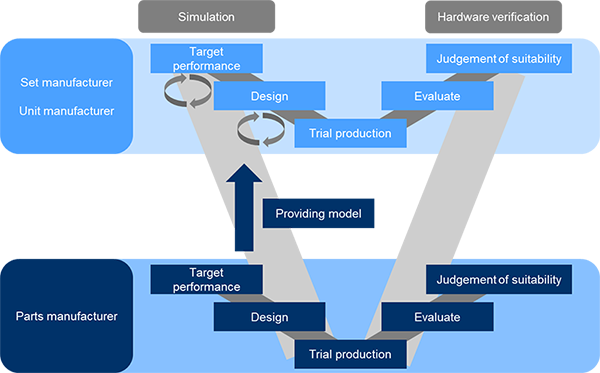
The overall picture of automotive semiconductor models
The following table shows the automotive semiconductor models available from our company.
| Automotive semiconductor model | Electric model | Thermal analysis model | |||||
|---|---|---|---|---|---|---|---|
| Tools/Format | Pspice® | LTspice® | SIMetrix™ | ELDO® |
Xpedition AMS | STEP | |
| Distrite semiconductor | ◎ | ◎ | ◎ | ◎ | 〇 | ◎*2 | |
| IC | Motor driver |
◎*1 | ー | ー | ー | 〇 | 〇*3 |
| IPD (Intelligent Power Device) | ◎*1 | ー | ー | ー | ー | 〇*3 | |
Automotive Communication IC (CXPI) |
ー | ー | ー | ー | 〇 | 〇*3 | |
◎; Available and now open to the public
〇; Available, lnquiry required
*1; Partialy available
*2; A simplified CFD model for thermal analysis is now available on the web, and detailed models are available upon inquiry.
*3; detailed models are available upon inquiry.
Toshiba's automotive semiconductor models
1. Discrete semiconductor models
As for the electrical models of automotive discrete semiconductor products, we have prepared two types of SPICE models with different granularities. One is the G0 model, which is suitable for function checks due to its fast calculation speed. The other is our proprietary G2 model (high-precision SPICE model) developed for MOSFET products. The G2 model is created in a macro-model format based on BSIM3, using the least possible number of elements and nonlinear elements with continuous arbitrary functions to represent the electrical characteristics of the target elements. As a result, it has features such as minimizing the increase in node count that leads to convergence issues and slower calculation speeds, which are disadvantages of traditional macro models. Furthermore, it excels in reproducing the high-current region characteristics of the ID-VDS curve and the capacitance characteristics with nonlinearity, enabling highly accurate simulations close to actual measurements. It also considers the parasitic elements of the package, allowing for the analysis of ringing and EMI that occur during switching. Please refer to the application notes below for more detailed information.
Automotive Discrete Semiconductor MBD Introductory (PDF:1.49MB)
The G2 model (high-precision SPICE model) is introduced in the link below.
High accurate SPICE models that can more accurately simulate the transient characteristics of power devices
We provide SPICE models compatible with various simulation tools. Specifically, in addition to the models for PSpice® and LTspice® shown in the table, we have also started web publication of SIMetrix® models and ELDO® models. The various models can be checked from the link below
EDA/CAD Model Library
Details of the simplified CFD model for thermal analysis of discrete semiconductor products are introduced in the link below.
Cooling simulation model: Expanding the number of Simplified CFD Models for three-dimensional thermal fluid analysis in MOSFETs
2. IC Models
Introduction of Functional Verification, "Thermal Analysis, EMC Analysis, and Control Analysis using models of ICs under development. For inquiries and considerations regarding each analysis model, please contact us at the link at the bottom of the inquiry page.
Functional Verification
Toshiba is focused on developing new IC products for automotive motor systems and automotive communication systems. Figure 1 is an example of a simulation using Xpedition AMS, which combines the model of the H-bridge gate driver IC (TB9103FTG: under development) with power MOSFET (G2) models and mechanical models such as motors. Figure 2 monitors the voltage applied to each MOSFET driven by a control signal that repeatedly reverses and inverts at the IC's input terminals (IN1, IN2). The lower part of Figure 2 shows an enlarged view of the gate voltage (V(GH1)) and source voltage (V(SH1)) of the high-side MOSFET during the dashed period. With this IC model, it is possible to closely observe the operation of the IC and the behavior of the MOSFET during driving.
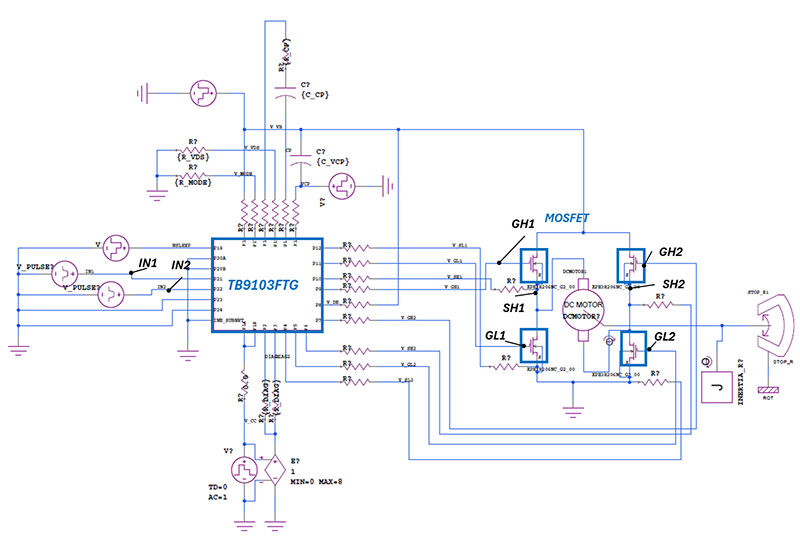
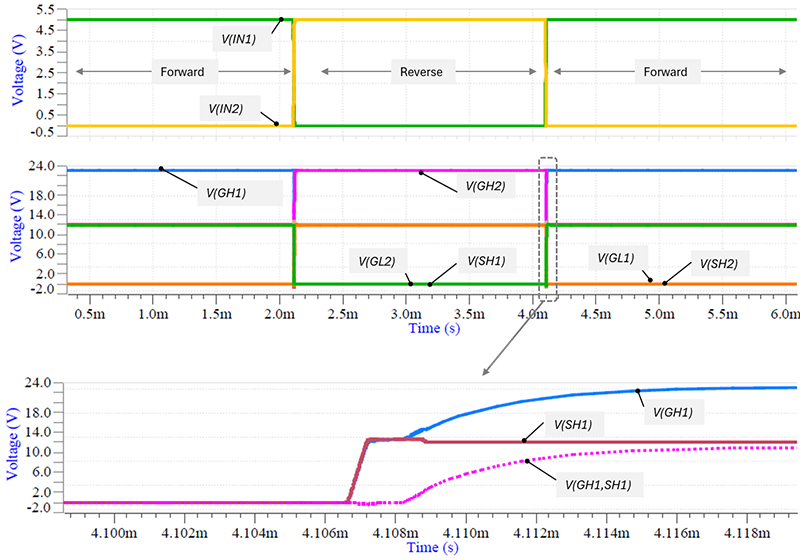
* This model is under development and subject to further improvements and modifications, therefore the configuration and results of the simulation may change.
Thermal Analysis
In automotive electronics, the operating environment is becoming increasingly harsh with high-density mounting and high ambient temperatures, leading to various thermal issues due to the impact of electronic components used, their placement, and PCB design. To prevent these issues proactively, it is becoming necessary to perform thermal analysis in the early stages of development. Our company provides detailed models in STEP format for thermal analysis of ICs. Please contact us for the use of models, including products not listed.
| Category | Product | Features | Package | Thermal model |
|---|---|---|---|---|
| CXPI | TB9032FNG | CXPI driver receiver | P-SOP8-0405-1.27-002 |
STEP formats |
| Brushed Motor Driver | TB9051FTG | H-Bridge driver (1ch) | P-QFN28-0606-0.65-001 | |
| TB9052FNG | DC brushed motor GATE-driver (1ch) | HTSSOP48-P-300-0.50 | ||
| TB9053FTG | H-Bridge driver (2ch) | P-QFN40-0606-0.50 | ||
| TB9054FTG | H-Bridge driver (2ch) | P-VQFN40-0606-0.50 | ||
| TB9056FNG | H-Bridge driver with LIN (1ch) | SSOP24-P-300-0.65A | ||
| TB9057FG | DC brushed motor GATE-driver (1ch) | LQFP48-P-0707-0.50 | ||
| TB9058FNG | H-Bridge driver with LIN (1ch) | SSOP24-P-300-0.65A | ||
| Brushless Motor Driver | TB9061AFNG | 3-phase sensorless motor GATE-driver | SSOP24-P-300-0.65A | |
| TB9080FG | 3-phase brushless motor GATE-driver (Built-in control logic that output si sine wave drive) |
LQFP64-P-1010-0.50E | ||
| TB9081FG | 3-phase brushless motor GATE-driver | QFP64-P-1010-0.50C | ||
| TB9083FTG | 3-phase brushless motor GATE-driver | P-VQFN48-0707-0.50-005 | ||
| Stepping Motor Driver | TB9120AFTG | 2-phase bipolar stepping motor driver (Excitation mode: up to 1/32) |
P-VQFN28-0606-0.65 | |
| SmartMCD™ | TB9M003FG | 3-phase brushless motor GATE-driver | P-HTQFP48-0707-0.50-001 |
* The STEP format is an ISO standard and is compatible with many 3D CAD tools, allowing for use in various fluid analysis tools such as Flotherm™ and Icepak™.
EMC Analysis
With the advancement of autonomous driving and the increased functionality of each system, the amount of information in vehicle communication networks is growing. In such an environment, EMC (Electro Magneticcompatibility) measures to ensure safety and reliability are becoming increasingly essential. However, designing automotive systems that take into account the effects of mutual interference between devices in the complex electromagnetic environment inside a vehicle is extremely challenging. Our company is working on model development and improvement aimed at realizing front-loading of EMC.
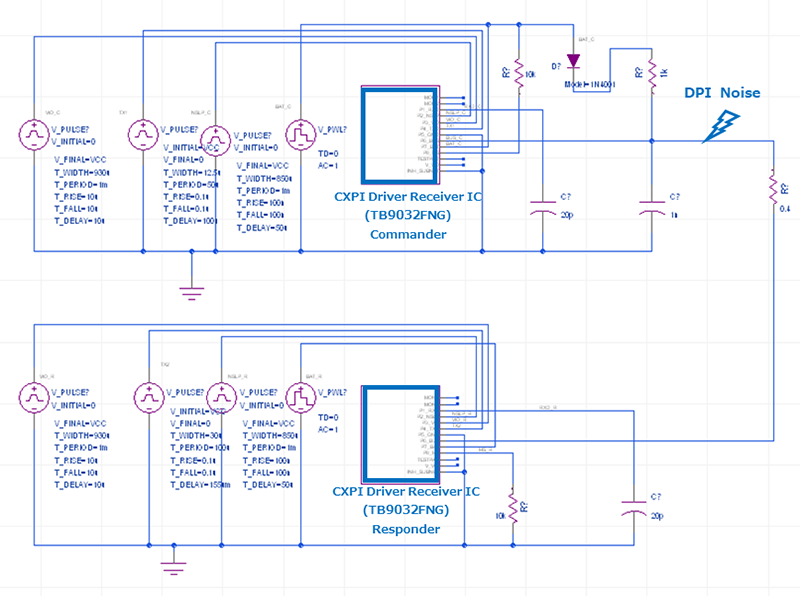
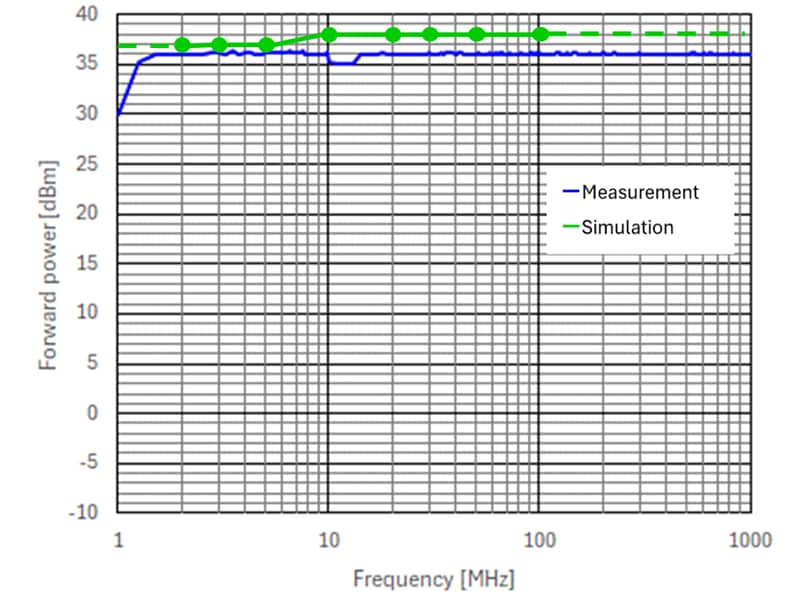
Control Analysis
Our company has started mass production and shipping of 'TB9M003FG', the first product in the 'SmartMCD™' series, which incorporates a microcontroller into the gate driver IC. In conjunction with this, we have prepared a HW block set that realizes SmartMCD™ hardware functions on MATLAB®/Simulink®, and a model for speed control utilizing hardware functions (Figure 5). By simulating our control model in combination with a motor model and a load model, you can evaluate system control using SmartMCD™. We are also preparing an automatic generation function for software that can be coupled with hardware-dependent device drivers from the control model. The automatic code generation function allows for easy transition of the evaluated model to actual hardware. Model-based development is realized through control evaluation and calibration with model simulations, and coordination with actual hardware through automatic code generation, reducing the development process.
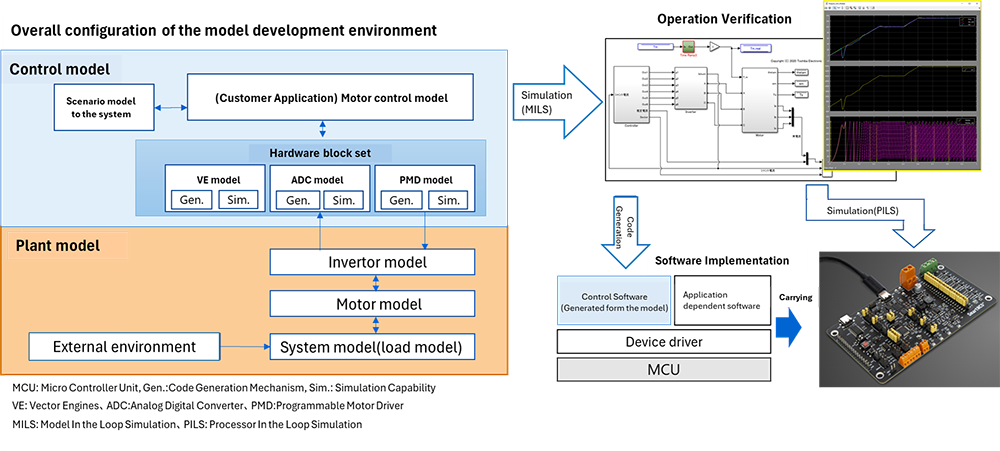
Related Links
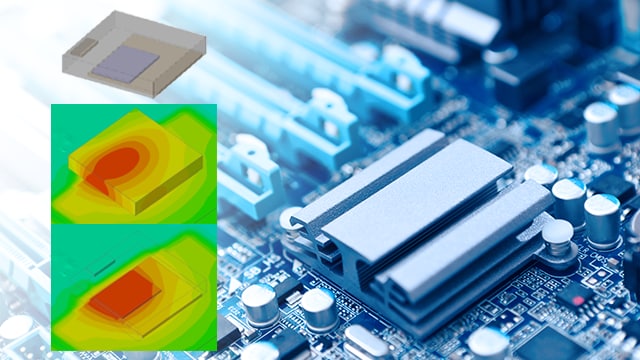
* SmartMCD™ is a trademark of Toshiba Electronic Devices & Storage Corporation.
* PSpice®is a trademark of Cadence Design Systems, Inc.
* LTspice® is a simulation software and tradenark of ADI (Analog Devices、Inc.).
* SIMetrix® is a simulation software and treadmark of SIMetrix Technologies Ltd. .
* Xpedition AMS is a sistemsimulator of Siemens EDA.
* Flotherm™ is a simulation software and tradenark of Simens.
* Icepak™ is a simulation software and tradenark of Ansys, Inc.
* MATLAB®/Simulink® is a simulation software and tradenark of MathWorks, Inc.
* VenetDCP® is a tradenark of Toshiba Digital Solutions Corporation.
* Company names, product names, and service names may be trademarks of their respective companies.




